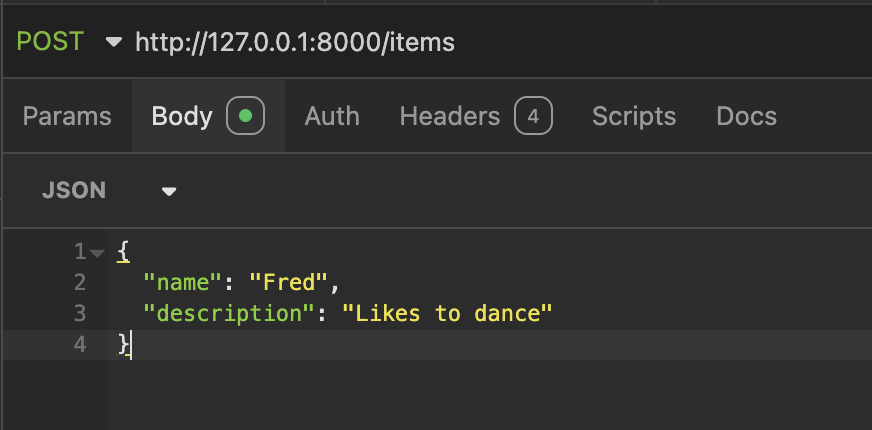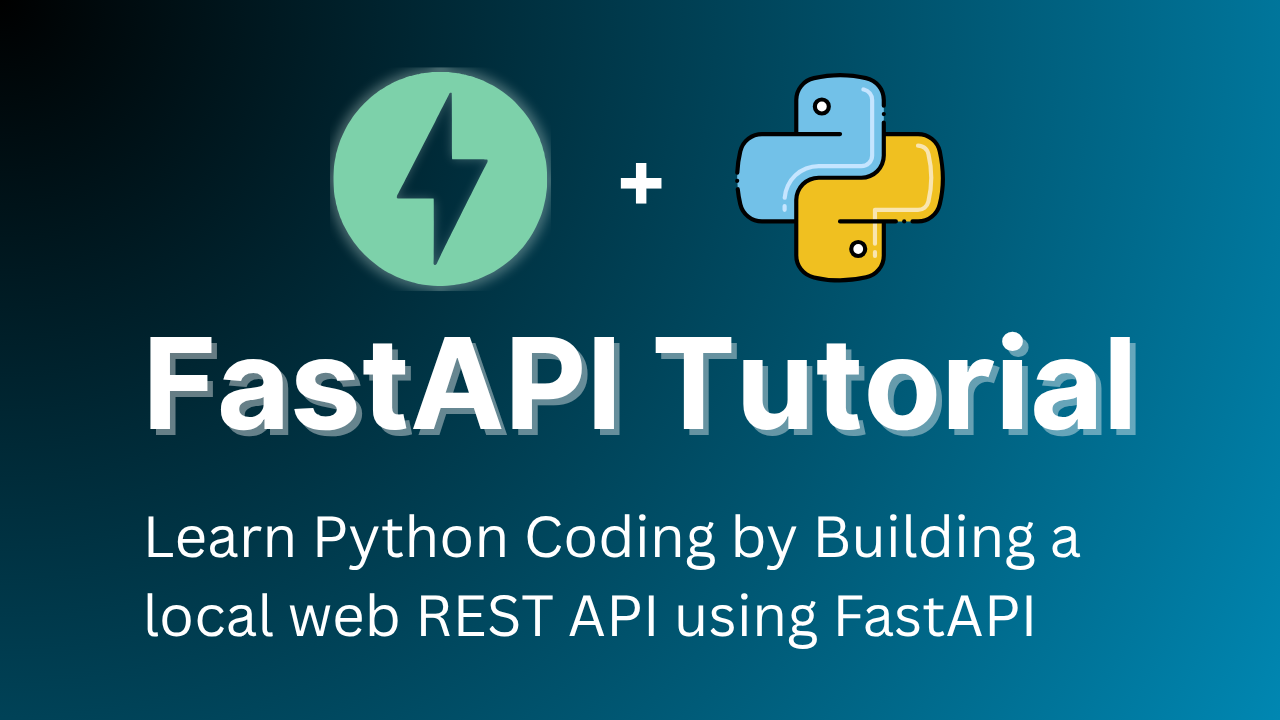Building a Simple API with Python
A guided step-by-step tutorial that shows how Web API’s work. You’ll learn how to use API Tools to get data and even build your own web api using python.
What is an API
API stands for Application Programming Interface. Unless specified, the type of API being referenced in conversation usually references a web application API like FastAPI (python) or Express API (javascript / nodejs)
Tools we need
- A computer with Python
- An IDE (Integrated Development Environment) VS Code Recommended
- This is
VS CodeNOTVisual Studio.
- This is
- An API Testing Tool like: Insomnia or Postman
Learning by playing
Rather than going into immense detail we’ll instead build a simple web API and then test it out. We’ll start off with 🐍 Python utilizing a library called 🛞 FastAPI.
The app is a simple web server that will let you add items and get the items you’ve added.
Project Start
In your Terminal / Command Prompt. Create a new directory called: fast_api_items
mkdir fast_api_items
Open your new folder in your IDE. For this example I will use VSCode
In VSCode open a New Terminal and type:
# mac and/or linux
python3 -m venv venv
# windows
python -m venv venv
In your project directory this will create a new folder called venv
Once again in the Terminal type the following:
# Windows
# - cmd / command prompt
.\venv\Scripts\activate
# - PowerShell
.\venv\Scripts\Activate.ps1
# Mac or Linux
source /venv/bin/activate
Once you do this… you should see something like (venv) show up in the terminal. This means you now have a virtual python environment up and running.
::: details Why do I need a virtual environment?
Okay! Imagine you’re building a LEGO set.
A Python virtual environment is like a special LEGO table where you only keep the pieces you need for one project. That way, if you’re building a spaceship, your table only has spaceship pieces — no pirate ship parts or castle bricks to get in the way!
Why it’s good:
Keeps your project clean and organized.
Makes sure your code always uses the right tools (even if other projects use different ones).
Helps you not break other projects by accident.
So it’s like your own little safe bubble for coding — and each project gets its own bubble! 🫧👩💻🧑💻 :::
Back in your terminal type:
pip install fastapi uvicorn
This will install the libraries fastapi and uvicorn in your (venv) directory. Let it run and install.
Let’s create the API application.
Create a file called main.py in the root of your project folder. Then add the following lines and save it.
from fastapi import FastAPI
from pydantic import BaseModel
app = FastAPI()
# Pydantic model for the request body
class Item(BaseModel):
name: str
description: str = None
# In-memory storage
items = []
# This is home or root of your website api
@app.get("/")
async def read_root():
return {"message": "Welcome to the API"}
# This will still display on the website ending with: /items
# This will show all the items you created
@app.get("/items")
async def read_items():
return items
# This requires an api tool to test
@app.post("/items")
async def create_item(item: Item):
items.append(item.dict())
return item
Now let’s run the application by typing the following command in your terminal.
uvicorn main:app --reload
::: details What is the uvicorn python library
URL: https://www.uvicorn.org/
Imagine you’re putting on a puppet show. You have your puppets (your Python code), but you need a stage and someone to open the curtain and let people watch. Uvicorn is like that helpful person who opens the curtain and invites the audience in. It helps your Python code talk to the internet so people can see and use what you’ve built.
Now, here’s something cool: when you’re practicing your puppet show and decide to change a puppet’s costume or add a new scene, Uvicorn notices the change and restarts the show automatically. This means you don’t have to stop and start everything again—it just updates the show for you!
So, if you made a cool game or a website with Python, Uvicorn helps share it with others and keeps everything updated as you make changes! :::
This will spin up a local web server at: http://127.0.0.1:8000 or whatever your localhost IP is set to. You can also just type: http://localhost:8000
In a web browser (chrome, edge, brave, firefox, etc.) you should see the following text…
{ "message": "Welcome to the API" }
After the number 8000, if you type: /items it should show square brackets [ ] because we haven’t added any items yet.
So how do we add items. Luckily for us, this app automatically created documentation when it was created. If you go to: http://localhost:8000/docs you should see documentation.
| Type | Description |
|---|---|
| GET | Read Root |
| GET | Read or Display Items |
| POST | Create Item |
Click on the POST drop down. This shows something called the Request Body with example data wrapped in curly brackets with quotes around the text. This format if you’ve never seen it is called JSON (JavaScript Object Notation)
This is where the API Testing Tool comes into play. For this example we will be the using Insomnia application.
In the Insomnia application, I will create a New Collection
Add a new Request by providing the URL: http://localhost:8000/items and setting the Request Type to POST
Think of this like an html web form or web application where you add a new item. But instead of an easy to use form, we are going to send a specialized text format.

In the POST Request select the Body tab. You should see a drop-down. Select JSON.
Copy the following text and paste it into the JSON Body
{
"name": "Fred",
"description": "Likes to dance"
}
Back in the browser, go to: http://localhost:8000/items and you should see the JSON text we just added.
Let’s jump back into our API Tool (Insomnia) and add another item by replacing the current JSON data with…
{
"name": "Susan",
"description": "Likes to run"
}
Once more refresh the website: http://localhost:8000/items and you should see the other items.
Let’s add another person but this time add a new key labelled age and set it to 28
{
"name": "May",
"age": 28,
"description": "Enjoys spring"
}
You’ll be able to create the person but it won’t add the age value. This is because back in the python code for the main.py we said objects can only have a name and description.
Let’s dig into the code
In your IDE VS Code open main.py and locate the line…
# Pydantic model for the request body
class Item(BaseModel):
name: str
description: str = None
You don’t need to understand python. All you need to know is that the code above is creating a new object we called Item and that we’ve given this Item object two keys, fields, or columns. Imagine this is in a table and we’ve created the columns: name and description. In this code, instead of columns we have keys with values.
Even though in the Insomnia API testing tool it let’s us add the key age with a value, it will just ignore this key because we didn’t provide this key when we created the Item object.
Let’s add a new key (column) to the Item object. We will also set the data format to an int (number) and we set it’s default value to 0 (zero).
# Pydantic model for the request body
class Item(BaseModel):
name: str
description: str = None
age: int = 0
Make sure to save your changes. Since we saved our changes the server will automatically restart clearing out the local data or the objects we created.
Let’s go back to Insomnia and run the POST Request again. This will create a new item with a value for age.
Endpoint Basics
Right now we see our new items at: http://localhost:8000/items but we can set this to anything.
In the code find the section:
@app.get("/items")
async def read_items():
return items
Change the /items to /people and save. Our items in the local memory will be wiped out again. Let’s once again add a user with an age key and value. Then repeat the step and add two other people with different information.
Open your browser and now go to: http://localhost:8000/people to see the people items you created.
Finished
Play around with this a little, change the endpoints, add new keys, or create an item with only a name. Have fun!
